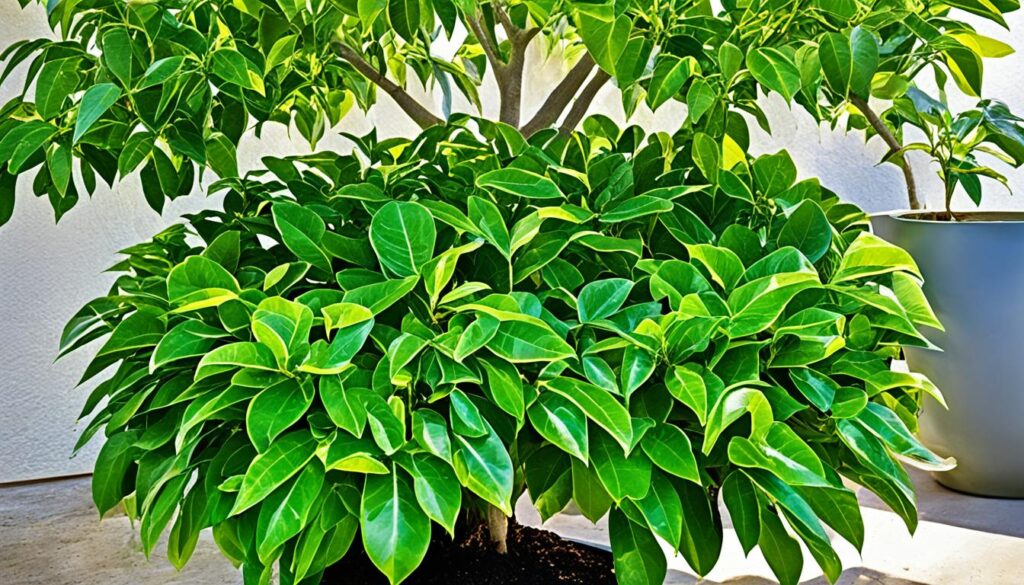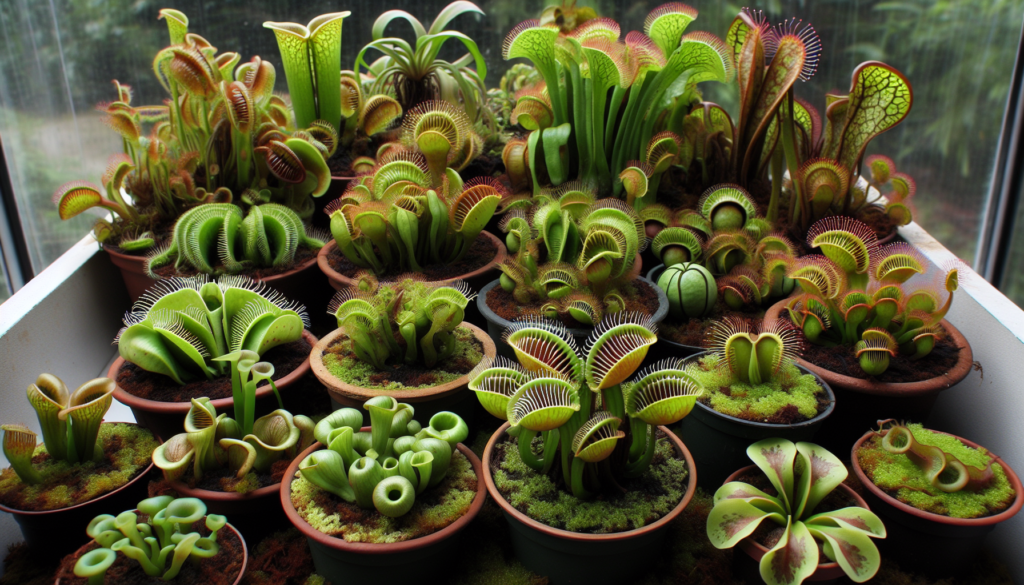Ficus plants, or figs, are popular indoor greens. They bring a bit of the tropics indoors. But, to keep them looking great, they need the right care. Container-grown ficus especially need more care because they run out of nutrients faster than outdoor ones.
To make your ficus thrive, use the best indoor plant fertilizer. A good plan for feeding them will lead to strong, beautiful plants.
Key Takeaways
- Ficus plants grown in containers require more frequent fertilizing due to limited soil volume.
- A balanced N-P-K fertilizer is recommended during the growing season for ficus.
- Yellow leaves on ficus can indicate nutrient deficiencies like nitrogen or potassium.
- FoxFarm Grow Big and Espoma Organic Indoor! are excellent liquid fertilizer options for ficus.
- Following proper dilution and application instructions is crucial for successful ficus fertilization.
Why Fertilize Ficus?
Keeping your ficus plants fed is key to their health. As they grow, they take nutrients from the soil. This can leave the soil lacking in what the ficus needs. If not fed right, your ficus can’t grow well.
Replenishing Nutrients
The soil in your ficus pot loses nutrients over time. So, you need to add fertilizer. This feeds your plant the key nutrients it uses to grow well and stay healthy.
Promoting Healthy Growth
Feeding your ficus the right nutrients supports its growth. The best fertilizer has the correct NPK ratio. A good mix (3 parts nitrogen, 1 part phosphorus, and 2 parts potassium) helps your ficus get big and strong.
Preventing Pest and Disease Problems
Good fertilization not just encourages growth. It also helps your ficus fight off bugs and diseases. Plants lacking in nutrients are easier targets for pests. When well-fed, your ficus can better defend itself.
- Feed your Ficus sinuata about once a month during the growing season to keep it healthy.
- Use fertigation by mixing water and fertilizer. This spreads nutrients evenly in the soil.
- Watch out for too much fertilizer. It can cause leaf problems, excessive fertilizer on the soil, and hurt the roots.
Knowing the importance of feeding your ficus is essential. It ensures you’re growing thriving plants both indoors and outdoors.
Essential Nutrients for Ficus
Keeping your ficus plants healthy means giving them the right nutrients. These lush plants need the correct food to grow strong and vibrant. The three key nutrients for ficus are nitrogen, phosphorus, and potassium. They help the plants grow and stay healthy.
Nitrogen for Plant Growth
Nitrogen is vital for making your plants look green and full. It helps leaves grow and keeps them a bright green. Use a fertilizer high in nitrogen, such as 10-6-6, in the spring and summer. This will boost your plant’s growth.
Phosphorus for Root Development
Phosphorus is important for strong roots and overall plant health. It ensures a healthy root system can take in water and nutrients. Phosphorus also helps your plant bloom and bear fruit.
Potassium for Nutrient Transport
Potassium aids in moving nutrients and water within the plant. It’s essential for key plant functions like photosynthesis and making enzymes work. The right amount of potassium keeps your ficus strong and able to fight off problems.
Using a well-rounded fertilizer that includes nitrogen, phosphorus, and potassium is best. A 6-6-6 or 10-10-10 mixture is perfect for ficus. Also, adding organic fertilizers or compost helps keep nutrients flowing. It also boosts the quality of your soil and helps it hold water better.
Ficus Fertilizing
Potted ficus plants use up soil nutrients fast because of the small amount of soil they have. So, regular fertilizing is very important for them to grow well. Giving them the right amount of ficus fertilizing methods helps keep their green leaves and makes them strong.

- Choose a balanced, water-soluble fertilizer with a 3-1-2 N-P-K ratio. It’s perfect for ficus plants.
- Use liquid fertilizers. They make it easy to control how much nutrients you give your plant.
- In the growing season (from spring to fall), fertilize monthly. Follow the fertilizer directions carefully.
- Stop fertilizing or use less in the winter when the plant isn’t growing much.
Finding the right fertilizer amount is key. Too much can damage the roots. Too little slows growth and causes lack of nutrients.
| Ficus Species | Fertilizer Type | Frequency |
|---|---|---|
| Fiddle Leaf Fig | Liquid Fertilizer (e.g., Fiddle Leaf Fig Food) | Every 7-14 days |
| Ficus Nitida (Indian Laurel) | Moon Dust Fertilizer, Super Charged Moon Juice | Monthly (March-October) |
| Ficus Audrey | Water-soluble Houseplant Fertilizer | Monthly (follow label instructions) |
But remember, fertilizing is only one part of caring for your ficus. It also needs enough light, the right temperature, humidity, and the correct amount of water. This helps your ficus stay beautiful whether it’s inside or outside.
Signs of Nutrient Deficiency
Ficus trees are lovely plants for inside or outside. But, they need the right fertilizer to stay healthy. You must know the signs when they lack nutrients. This helps keep their leaves bright and growing well.
Yellow Leaves
If a ficus plant’s leaves turn yellow, it needs more nutrients. This usually means there’s a lack of nitrogen or potassium. You’ll see the yellowing first on the older leaves inside the tree. Use a fertilizer that’s balanced and full of these key nutrients to help your plant.
Purple-Tinged Leaves
Spotting purple leaves means the plant lacks phosphorus. This can also make the plant grow poorly. Phosphorus is very important for the roots and the plant’s general health. Using a fertilizer with enough phosphorus can make your plant better.

Stunted Growth
- Lack of new growth or slowed growth rate
- Smaller-than-expected leaf size
- Reduced stem elongation
Slow or no growth shows your ficus lacks some nutrients. It might not grow new leaves or its leaves might be small. Or, its stems could be short. A good, balanced fertilizer is what it needs to grow well again.
Leaf Curling, Wilting, and Dropping
Wrinkled, wilting, or falling leaves show several nutrient needs. It might need more nitrogen, phosphorus, or potassium. These nutrients are vital for the plant’s health. Correcting this with fertilizer can make your ficus healthy again.
Knowing the signs of ficus nutrient deficiency is key. This lets you make your plant healthier by giving it the right nutrients. This way, your ficus can grow and look great.
Best Fertilizers for Ficus
Choosing the right fertilizer is key for your ficus tree’s health and natural beauty. Go for organic liquid fertilizers to give your plant what it needs.
FoxFarm Grow Big Liquid Concentrate
FoxFarm’s Grow Big Liquid Concentrate is perfect for ficus. It has a 6-4-4 NPK balance, which is great for growth.
- This fertilizer includes natural stuff like bat guano and earthworm castings. These help your plant grow strong.
- Mixing and using it is simple for regular feeding.
- It helps your plant’s leaves, stems, and roots grow healthy and strong.
Espoma Organic Indoor Liquid Fertilizer
Another good pick is Espoma’s Organic Indoor Liquid Fertilizer. It’s got a 2-2-2 NPK mix, perfect for indoor plants like ficus.
- It’s made with things like feather meal and bone meal to feed your plant gently.
- Applying this liquid works well and is safe for the plant’s roots.
- Your ficus will be healthier and defend against bugs and diseases better.
Both FoxFarm Grow Big and Espoma Organic Indoor! are top organic ficus fertilizers. They give your ficus what it needs to be healthy. Just make sure you use them as the labels say.
Proper Fertilizing Schedule
Keeping a proper ficus fertilizing schedule is key. It helps your Audrey Ficus grow full and vibrant. Audrey Ficuses need different nutrients when they are growing actively or resting. By feeding your plant the right way at the right time, you can make sure it looks great all year.
Growing Season Fertilization
In spring and summer, your ficus is busy growing. It needs a lot of nutrients then. Try to use a fertilizer with an NPK ratio of 20-20-20. This mix has what your plant needs to grow well. Use it every two to four weeks, but at half-strength to start. Your ficus will thank you with lots of big, healthy leaves.
- Optimal NPK ratio: 20-20-20
- Frequency: Every 2-4 weeks
- Dilution: Start with a half-strength solution
Dormant Season Considerations
When it gets colder, your ficus takes a break, so it doesn’t need as many nutrients. Just give it fertilizer every month then. Overfeeding during this time can hurt your plant. A little bit of fertilizer right after watering is often enough until it starts growing again.
Adjusting how you fertilize your ficus can keep it healthy all year. By giving it the food it needs when it’s growing and resting, you help it stay full of life.
Tips for Successful Ficus Fertilization
Keeping your ficus plants healthy requires good fertilization. Let’s look at some key tips for this:
Balanced N-P-K Fertilizers
Choosing the right ficus fertilizing tips means picking a balanced fertilizer. An N-P-K ratio of 20-20-20 is ideal. It ensures your ficus gets the needed nutrients for the best growth.
Nitrogen makes the leaves green. Phosphorus helps the roots grow strong. Potassium is for moving nutrients around the plant and keeps it healthy.
Liquid Fertilizers for Easy Application
Liquid fertilizers are great for how to fertilize ficus properly. Because they quickly soak into the roots and you can mix them precisely, they’re a good choice. This way, you avoid putting too much, which could hurt your plant.
Follow Label Instructions
Reading the fertilizer label is crucial. It tells you how much to use, how often, and how to mix it. Too much fertilizer can damage your ficus. So, following the label is vital to protect your plant.
Stick to these ficus fertilizing tips for healthy and beautiful ficus plants. Regular and proper care is the secret to a thriving ficus, whether inside or outside.
Watering and Ficus Fertilization
It’s key to water ficus plants right for them to take in fertilizer well. Ficus retusa bonsai can handle a lot, great for new plant owners. But, too much water is harmful. It’s vital to find the perfect amount; not too wet, not too dry.
Avoiding Over-Watering
Ficus trees should not get too much water. They need different amounts depending on the season. More water is needed during the summer but less in the winter. Remember, too much water is bad and can cause the roots to rot.
With ficus bonsai, let the soil dry a bit before you water again. Watch the leaves for any wilting, a sign they need water. Placing the plant in direct sunlight means it will need water more often.
Proper Drainage
Good drainage stops the plant from getting too much water. Use a proper soil mix and a pot that drains well. Don’t let the plant stay in water after you’ve watered it. This stops root rot and similar issues.
- Water the bonsai thoroughly, allowing excess water to drain out of the bottom of the pot.
- Discard any water that collects in the tray or saucer beneath the pot.
- Check the soil moisture regularly by sticking your finger into the soil or using a moisture meter.
Follow these tips to water your ficus bonsai right. With good drainage, the plant gets just the water it needs. And this helps it use fertilizer well too.
Pruning and Ficus Fertilization
Proper pruning is key for ficus plant health. It keeps them the right size and shape. Pruning lets the plant grow well by letting light and air in. You should prune ficus plants after they’ve been fed. This helps them recover faster.
- Prune no more than 30% of the ficus plant at a time to prevent it from becoming root-bound.
- Trim away any dead, diseased, or crowded branches, focusing on those that rub against the main trunk.
- Cut branches at a slant, aiming towards the growth node, to encourage new growth.
Pruning can stress the plant, so feed it right after. A balanced 8-8-8 fertilizer works best. Use it once a month in spring and summer. This replaces the nutrients lost in pruning and helps the plant recover.
| Ficus Pruning Tips | Fertilizing Recommendations |
|---|---|
| Prune no more than 30% at once | Apply an 8-8-8 fertilizer monthly |
| Remove dead, diseased, or crowded branches | Fertilize during spring and summer |
| Cut at a slant towards growth nodes | Reduce fertilization in fall and winter |
Following these tips for pruning ficus and fertilizing after pruning ensures their health. With care, your ficus plants will grow beautifully for many years.
Environmental Factors and Ficus Fertilization
It’s vital to set the right scene for your ficus plants to soak up nutrients from fertilizers. Light, heat, and how much moisture is in the air affect the plants’ growth and how well they use the fertilizer.
Light Requirements
Ficus plants love bright, filtered light. Direct sun might burn their leaves, especially the variegated ones. Yet, they do still need lots of light to photosynthesize and grow well. Make sure your ficus gets the right amount of light and nutrients.
Temperature Preferences
Ficuses like it warm, between 59°F and 75°F (15°C to 24°C). Too cold can slow their growth and lead to a lack of nutrients. But, too hot stresses them out and affects nutrient use. Keep the temperature steady for your ficus to do its best.
Humidity Levels
They also need a fair bit of ficus humidity because they’re tropical. If it’s too dry, their leaves might turn brown, curl up, or even fall off. To fix this, you can use a humidifier or a pebble tray to up the humidity. This creates a better home for your ficus and helps it use fertilizer better.
By getting these environmental factors just right, your ficus plants will thrive. They’ll take in nutrients better from the fertilizer you give them.
| Environmental Factor | Optimal Range | Impact on Fertilization |
|---|---|---|
| Light | Bright, filtered light | Proper photosynthesis and growth for nutrient utilization |
| Temperature | 59°F to 75°F (15°C to 24°C) | Consistent warmth promotes nutrient absorption |
| Humidity | Moderate levels | Prevents leaf issues that hinder nutrient uptake |
When you get the light, heat, and moisture just right, your ficus plants will do very well. The fertilizers you use will help them grow lush and full of life.
Conclusion
To grow a healthy ficus, using the right fertilizer and a good schedule is key. Proper nutrients help the plants grow well, showing off bright leaves and full coverage. Understanding what your ficus needs leads to success when fertilizing them.
Use a balanced fertilizer made for ficus or general houseplants in the growing season. Stop or slow down fertilizing in the winter when plants rest. Watch for signs your plant needs more nutrients and adjust your care. Keeping your ficus healthy brings joy for many years.
By using the advice from this article, you’re ready to care for your ficus. Regular, careful fertilizing keeps your plants vivid and healthy. This simple step is essential for a thriving ficus garden.






